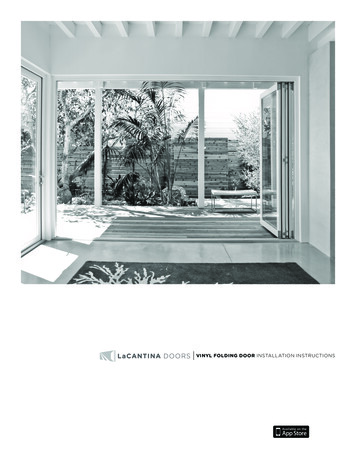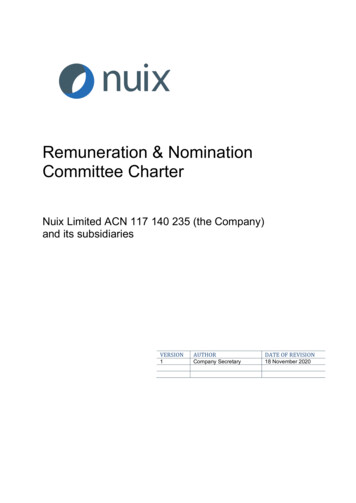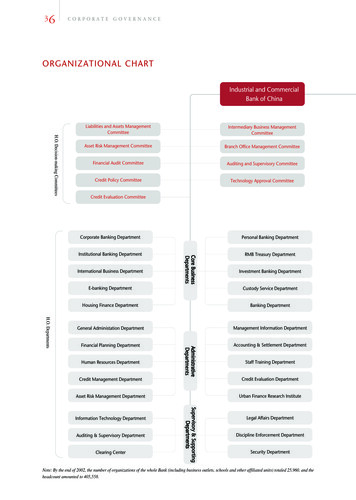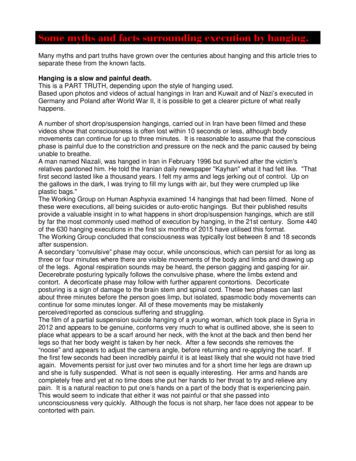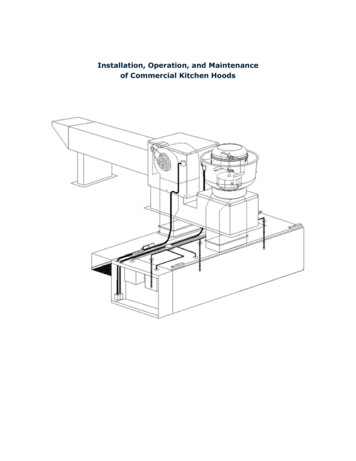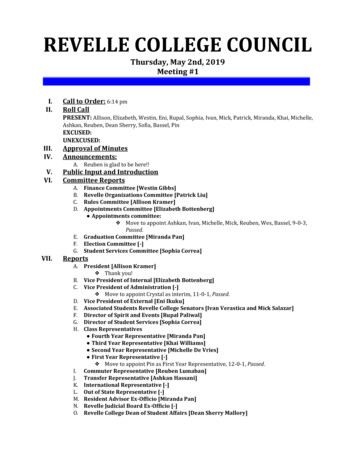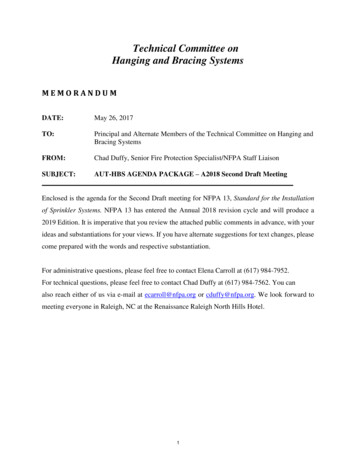
Transcription
Technical Committee onHanging and Bracing SystemsMEMORANDUMDATE:May 26, 2017TO:Principal and Alternate Members of the Technical Committee on Hanging andBracing SystemsFROM:Chad Duffy, Senior Fire Protection Specialist/NFPA Staff LiaisonSUBJECT:AUT-HBS AGENDA PACKAGE – A2018 Second Draft MeetingEnclosed is the agenda for the Second Draft meeting for NFPA 13, Standard for the Installationof Sprinkler Systems. NFPA 13 has entered the Annual 2018 revision cycle and will produce a2019 Edition. It is imperative that you review the attached public comments in advance, with yourideas and substantiations for your views. If you have alternate suggestions for text changes, pleasecome prepared with the words and respective substantiation.For administrative questions, please feel free to contact Elena Carroll at (617) 984-7952.For technical questions, please feel free to contact Chad Duffy at (617) 984-7562. You canalso reach either of us via e-mail at ecarroll@nfpa.org or cduffy@nfpa.org. We look forward tomeeting everyone in Raleigh, NC at the Renaissance Raleigh North Hills Hotel.1
Table of ContentsPart 1 - Meeting AgendaPart 2 - Committee Address ListPart 3 – New Process WorksheetsPart 4 – A2018 First Draft Meeting MinutesPart 5 - A2018 Key DatesPart 6- HBS Public Comments2
PART 1 –MEETING AGENDA3
Technical Committee on Hanging and Bracing SystemsSecond Draft MeetingJune 19 - 20, 2017Renaissance Raleigh North Hills Hotel4100 Main at North Hills StreetRaleigh, NC 27609AGENDAMonday, June 19, 20171. Call to Order – 8:00 AM2. Task Group Meetings ONLY3. Concrete Anchors Task Group: Duggan – Chair, Bachman, Berry, Deutsch, Deneff,Gillengarten, Jeltes, Tauby & Valentine4. Adjournment TBDTuesday, June 20, 2017Call to Order – 8:00 AMIntroductions of Members and StaffReview and Approval of A2018 First Draft Meeting MinutesReview of A2018 Revision Cycle and Meeting ScheduleReview of Distributed Material and Workloadb. Overview of Public Commentsc. Overview of Potential Committee Second Revisions6. Task Group Reportsa. Concrete Anchors Task Group7. Review Public Comments8. Adjournment TBD1.2.3.4.5.4
PART 2 –COMMITTEE ADDRESS LIST5
Address List No PhoneHanging and Bracing of Water-Based Fire Protection SystemsAutomatic Sprinkler SystemsJames B. BigginsSE 1/16/1998ChairAUT-HBSTUV SUD America Inc./Global Risk Consultants Corporation15732 West Barr RoadManhattan, IL 60442-9012Steve BerryPrincipalRaleigh Fire Department310 West Martin StreetRaleigh, NC 27602Christopher I. DeneffPrincipalFM Global270 Central AvenuePO Box 7500Johnston, RI 02919Alternate: Sorrel M. HansonThomas J. ForsythePrincipalJENSEN HUGHES2950 Buskirk AvenueSuite 225Walnut Creek, CA 94597-8862Alternate: Jeffrey E. HarperJeff HebenstreitPrincipalUL LLC484 Tamarach DriveEdwardsville, IL 62025-5246Alternate: Emil W. MisichkoDavid J. JeltesPrincipalPentair/ERICO International Corporation31700 Solon RoadSolon, OH 44139Alternate: Scott E. AndersonJoe BeagenPrincipalFlexhead Industries56 Lowland StreetHolliston, MA 01746Alternate: Robert E. Bachman05/25/2017David R. HagueAUT-HBSM 04/05/2016AUT-HBSE 10/29/2012 Samuel S. DannawaySE 4/17/1998AUT-HBS PrincipalAUT-HBSCoffman Engineers/S. S. Dannaway Associates, Inc.501 Sumner Street, Suite 421Honolulu, HI 96817-5304I 9/30/2004 Daniel C. DugganAUT-HBS PrincipalVibration & Seismic Technologies, LLC1318 Colony Way CourtChesterfield, MO 63017Alternate: Daniel J. DugganM 10/23/2003AUT-HBSSE 1/16/1998 John D. GillengertenU 7/14/2004AUT-HBS PrincipalAUT-HBSConsulting Structural Engineer1055 Rivermeade DriveHebron, KY 41048Building Seismic Safety Council/Code Resource SupportCommitteeRT 08/11/2014 Mark HopkinsAUT-HBS PrincipalNational Fire Sprinkler Association514 Progress Drive, Suite ALinthicum Heights, MD 21090National Fire Sprinkler AssociationDesign TechnicianAlternate: Jeffrey A. HewittM 8/9/2011 Kraig KirschnerAUT-HBS PrincipalAFCON9600 Klingerman StreetPO Box 3365South El Monte, CA 917336M 11/30/2016AUT-HBSM 10/10/1997AUT-HBS1
Address List No PhoneHanging and Bracing of Water-Based Fire Protection SystemsAutomatic Sprinkler SystemsAlan R. LagunaPrincipalMerit Sprinkler Company, Inc.930 Kenner AvenuePO Box 1447Kenner, LA 70062-1447Leslie “Chip” L. Lindley, IIPrincipalLindley Fire Protection Company Inc.2220 East Via BurtonAnaheim, CA 92806Alternate: Joseph NormandeauIM 10/3/2002 Philip D. LeGroneAUT-HBS PrincipalRisk Management Solutions, Inc.4247 Lindawood DriveNashville, TN 37215SE 7/12/2001AUT-HBSIM 8/9/2011 Wayne M. MartinAUT-HBS PrincipalWayne Martin & Associates Inc.136 Bardsdale AvenueOxnard, CA 93035SE 10/10/1997AUT-HBSMichael Wade McDanielIM 04/04/2017PrincipalAUT-HBSF TechVolcan Momotombo2714, Col. El Colli UrbanoZapopan, Jalisco, 45070 MexicoMexican Fire Sprinkler Association (AMRACI)Marco R. NieraethPrincipalGlobal Asset Protection Services, LLC5641 Pepperwood AvenueLakewood, CA 90712-1733Alternate: Todd A. DillonJ. Scott MitchellPrincipalCNS Y-12127 Westview LaneOak Ridge, TN 37830I 3/2/2010 Janak B. PatelAUT-HBS PrincipalChicago Bridge and Iron3704 Clark CrossingMartinez, GA 30907-4934Michael A. RothmierL 4/17/1998PrincipalAUT-HBSUA Joint Apprenticeship Committee LU 66914252 Pikeminnow PlaceBroomfield, CO 80023United Assn. of Journeymen & Apprentices of thePlumbing & Pipe Fitting IndustryAlternate: Charles W. KetnerPeter T. SchwabPrincipalWayne Automatic Fire Sprinklers, Inc.222 Capitol CourtOcoee, FL 34761-3033Alternate: Ryan Peterson05/25/2017David R. HagueAUT-HBSDaniel SanchezPrincipalCity of Los AngelesBuilding & Safety201 North Figueroa Street, Suite 400Los Angeles, CA 90012IM 3/15/2007 Zeljko SucevicAUT-HBS PrincipalVipond Fire Protection6380 Vipond DriveMississauga, ON L6M 3C1 CanadaCanadian Automatic Sprinkler AssociationAlternate: Jason W. Ryckman7U 08/17/2015AUT-HBSU 10/10/1997AUT-HBSE 10/29/2012AUT-HBSIM 11/2/2006AUT-HBS2
Address List No PhoneHanging and Bracing of Water-Based Fire Protection SystemsAutomatic Sprinkler SystemsJames TaubyPrincipalMason Industries, Inc.350 Rabro DriveHauppauge, NY 11788Alternate: Scott ButlerGlenn E. ThompsonPrincipalLiberty Mutual InsuranceNI Property - West Division790 The City Drive, Suite 200Orange, CA 92868Alternate: Joseph R. SanfordVictoria B. ValentinePrincipalSociety of Fire Protection Engineers (SFPE)1 Trails EndHopewell Junction, NY 1253305/25/2017David R. HagueAUT-HBSM 10/10/1997 Jack W. ThackerAUT-HBS PrincipalShambaugh and Sons5430 E The ToledoLong Beach, CA 90803Alternate: John DeutschIM 10/10/1997AUT-HBSI 10/27/2005 Michael TosunianAUT-HBS PrincipalEaton Tolco1260 Northwood AvenueBrea, CA 92821National Fire Sprinkler AssociationManufacturerAlternate: Scott SantosM 12/08/2015AUT-HBSSE 04/04/2017 Kenneth W. WagonerAUT-HBS PrincipalParsley Consulting Engineers350 West 9th Avenue, Suite 206Escondido, CA 92025-5053American Fire Sprinkler AssociationInstaller/MaintainerAlternate: Duane JohnsonIM 10/4/2007AUT-HBSRonald N. WebbPrincipalS.A. Comunale Company, Inc.2900 Newpark DriveBarberton, OH 44203National Fire Sprinkler AssociationContractorAlternate: Sheldon DacusIM 1/14/2005 Thomas G. WellenAUT-HBS PrincipalAmerican Fire Sprinkler Association, Inc.12750 Merit Drive, Suite 350Dallas, TX 75251American Fire Sprinkler AssociationDesign TechnicianAlternate: Ray LambertIM 7/28/2006AUT-HBSWarren Douglas WilsonPrincipalScottsdale Fire Department7447 E Indian School Road, Suite 125Scottsdale, AZ 85251E 3/3/2014 Scott E. AndersonAUT-HBS AlternatePentair/ERICO International Corporation34600 Solon RoadSolon, OH 44139Principal: David J. JeltesM 10/29/2012AUT-HBSRobert E. BachmanM 11/2/2006AlternateAUT-HBSRobert E. Bachman, Consulting Structural Engineer25152 La Estrada DriveLaguna Niguel, CA 92677FlexHead Industries, Inc.Principal: Joe Beagen8Scott ButlerAlternateMason Industries, Inc.350 Rabro DriveHauppauge, NY 11788Principal: James TaubyM 10/23/2013AUT-HBS3
Address List No PhoneHanging and Bracing of Water-Based Fire Protection SystemsAutomatic Sprinkler SystemsSheldon DacusAlternateSecurity Fire Protection Company4495 Mendenhall RoadMemphis, TN 38141National Fire Sprinkler AssociationContractorPrincipal: Ronald N. WebbIM 10/10/1997 John DeutschAUT-HBS AlternateVFS Fire & Security Services501 West Southern AvenueAnaheim, CA 92865-3217Principal: Jack W. Thacker05/25/2017David R. HagueAUT-HBSIM 04/04/2017AUT-HBSTodd A. DillonAlternateGlobal Asset Protection Services, LLC1620 Winton AvenueLakewood, OH 44107Principal: Marco R. NieraethI 10/23/2003 Daniel J. DugganAUT-HBS AlternateVibration & Seismic Technologies30025 Alicia Parkway, #113Laguna Niguel, CA 92677Principal: Daniel C. DugganM 10/29/2012AUT-HBSSorrel M. HansonAlternateFM Global6320 Canoga AvenueSuite 1100Woodland Hills, CA 91367-2578Principal: Christopher I. DeneffI 08/17/2015 Jeffrey E. HarperAUT-HBS AlternateJENSEN HUGHES210 Salford DriveAlgonquin, IL 60102-5610Principal: Thomas J. ForsytheSE 11/2/2006AUT-HBSJeffrey A. HewittAlternateAmerican Fire Protection, Inc.5525 Eastcliff Industrial LoopBirmingham, AL 35210-5418National Fire Sprinkler AssociationDesign TechnicianPrincipal: Mark HopkinsM 10/29/2012 Duane JohnsonAUT-HBS AlternateStrickland Fire Protection5113 Berwyn RoadCollege Park, MD 20740 UsAmerican Fire Sprinkler AssociationInstaller/MaintainerPrincipal: Kenneth W. WagonerIM 04/05/2016AUT-HBSRay LambertAlternateWestern Fire Protection Inc.13630 Danielson StreetPoway, CA 92064American Fire Sprinkler AssociationDesign TechnicianPrincipal: Thomas G. WellenIM 08/09/2012AUT-HBSCharles W. KetnerL 1/10/2008AlternateAUT-HBSNational Automatic Sprinkler Fitters LU 669Joint Apprenticeship & Training Committee7050 Oakland Mills RoadColumbia, MD 20732United Assn. of Journeymen & Apprentices of thePlumbing & Pipe Fitting IndustryPrincipal: Michael A. RothmierEmil W. MisichkoAlternateUL LLC333 Pfingsten RoadNorthbrook, IL 60062-2096Principal: Jeff HebenstreitRT 10/10/1997 Joseph NormandeauAUT-HBS AlternateXL Fire Protection3022 N. Hesperian WaySanta Ana, CA 92706Principal: Leslie “Chip” L. Lindley, II9IM 08/03/2016AUT-HBS4
Address List No PhoneHanging and Bracing of Water-Based Fire Protection SystemsAutomatic Sprinkler SystemsRyan PetersonAlternateWayne Auto Fire Sprinklers4683 Laredo AvenueFort Myers, FL 33905Principal: Peter T. SchwabJoseph R. SanfordAlternateLiberty Mutual Property Risk Engineering20 Riverside RoadWeston, MA 02493-2231Principal: Glenn E. ThompsonDavid R. HagueStaff LiaisonNational Fire Protection Assocation1 Batterymarch ParkQuincy, MA 02169-747105/25/2017David R. HagueAUT-HBSIM 04/04/2017 Jason W. RyckmanAUT-HBS AlternateCanadian Automatic Sprinkler Association335 Renfrew Drive, Suite 302Markham, ON L3R 9S9 CanadaPrincipal: Zeljko SucevicI 08/11/2014 Scott SantosAUT-HBS AlternateSimplexGrinnell22282 Summit Hill DriveLake Forest, CA 92630National Fire Sprinkler AssociationManufacturerPrincipal: Michael TosunianIM 10/28/2014AUT-HBSM 08/03/2016AUT-HBSAUT-HBS105
PART 3 –NEW PROCESS WORKSHEETS11
NEW PROCESS ACTIONS AND MOTIONSPossible Action #1: Accept Public Comment (exactly as it is)Action RequiredSample motionCreate a Second RevisionI move to create a Second Revision using PC #.Possible action #2: Reject but see (revise submitted text)Action RequiredSample motionStep 1Create a Second Revision based on aPublic CommentI move to create a Second Revision based on PC# with the following changes to the text . .Step 2If the revision is related to multiple PCs,respond to all of them together using thecart functionI move to create a Second Revision based on PC# and incorporating PC #s with thefollowing changes to the text . . .Possible action #3: Reject (no change to the standard)Action RequiredSample motionI move to reject PC # with the followingsubstantiation . . .Generate a statement (substantiation)Possible Action #4: Reject but hold (new material)Action RequiredSample motionReject Public Comment for this cycle, butsave for next revision cycle12I move to reject PC # but hold it forconsideration during the First Draft meeting nextcycle.
PART 4 –A201 FIRST DRAFT MEETINGMINUTES13
Technical Committee on Hanging and Bracing of Water Based Fire Protection SystemsFirst Draft MeetingSan Diego Marriott Mission ValleySan Diego, CAJuly 12, 20161. Chairman James Biggins called the meeting to order at 8:00am and self-introductions weremade.2. Dave Hague gave a Staff report and presentation on general meeting procedures.3. The committee acted on all public inputs.4. There was no old business to discuss.5. There was no new business to discuss.6. The meeting adjourned at 5:00pm.14
AUT-HBS Task Groups - A2018Metal Deck – (International Issues)Thacker – er – TG LeaderPatelBerryOther Document CoordinationValentine - cevicWebbConcrete AnchorsDuggan - ubyValentineExtra Long Pipe Drops and Ceiling ConfigurationsBachman – ChairBeagenDeutschLambertThackerValentine15
PART 5 –A2018 KEY DATES16
2018 ANNUAL REVISION CYCLE* Public Input Closing Dates may vary according to standards and schedules for Revision Cycles may change. Please check theNFPA Website for the most up‐to‐date information on Public Input Closing Dates and schedules at www.nfpa.org/document # (i.e.www.nfpa.org/101) and click on Next Edition tab.ProcessStageProcess StepDates for TCDates for TCwith CCPublic Input Closing DateFinal date for TC First Draft MeetingPosting of First Draft and TC BallotFinal date for Receipt of TC First Draft ballotFinal date for Receipt of TC First Draft ballot ‐ recircPosting of First Draft for CC MeetingFinal date for CC First Draft MeetingPosting of First Draft and CC BallotFinal date for Receipt of CC First Draft ballotFinal date for Receipt of CC First Draft ballot ‐ recircPost First Draft Report for Public 73/1/2017Public Comment closing dateNotice published on Consent Standards (Standards that receive No /17/20181/24/2018Notice of Intent to Make a Motion (NITMAM) Closing DateTech Session Posting of Certified Amending Motions (CAMs) and Consent StandardsPreparation Appeal Closing Date for Consent Standards (15 Days after posting)(& Issuance) SC Issuance Date for Consent Standards (10 /4/20184/19/20184/29/2018Tech Session Association Meeting for Standards with CAMs6/4‐7/20186/4‐7/2018Appeals lic InputStage(First Draft)Note: Date varies and determined via TC ballot.Appeal Closing Date for Consent Standards (15 Days) (Standards That ReceivedNo Comments)Final date for TC Second Draft MeetingPosting of Second Draft and TC BallotCommentFinal date for Receipt of TC Second Draft BallotStage (SecondFinal date for receipt of TC Second Draft ballot ‐ recircDraft)Posting of Second Draft for CC MtgFinal date for CC Second Draft MeetingPosting of Second Draft for CC BallotFinal date for Receipt of CC Second Draft ballotFinal date for Receipt of CC Second Draft ballot ‐ recircPost Second Draft Report for NITMAM ReviewAppeal Closing Date for Standards with CAMs (20 Days after ATM)Council Issuance Date for Standards with CAMs*17
PART 6 –PUBLIC COMMENTS18
National Fire Protection Association Report25 of Fetcher?commentPara.Public Comment No. 128-NFPA 13-2017 [ Section No. 3.3.9 ]3.3.9 Automated Inspection and Testing.The use of procedures or equipment for the performance of inspections and testing of components testsat a distance from the system or component being inspected or tested through the use of electronicdevices or equipment installed for the purpose.Statement of Problem and Substantiation for Public CommentThis comment is in support of the definition for Automated Inspection and Testing but seeks consistency betweenthe related NFPA Standards. This language was approved by the NFPA 20 committee and should be correlatedwith NFPA 13, NFPA 13R and NFPA 14.Related ItemFR-719Submitter Information VerificationSubmitter Full Name: Robert UpsonOrganization:National Fire Sprinkler AssociationAffilliation:NFSA Engineering and Standards CommitteeStreet Address:City:State:Zip:Submittal Date:Tue May 09 08:25:17 EDT 2017195/17/17, 8:45 AM
National Fire Protection Association Report26 of Fetcher?commentPara.Public Comment No. 299-NFPA 13-2017 [ Section No. 3.3.34 ]3.3.34 Cloud Ceiling.Any ceiling system installed in the same plane with horizontal openings to the structure above on all two ormore sides. This does not include sloped ceilings as defined in 3.3.27.3.Statement of Problem and Substantiation for Public CommentThe original research used four open sides because that created a more challenging scenario. Rejecting thisallowance for fewer openings whereby less heat can get past the lower ceiling needs better justification than simplyblindly applying the test protocol without considering the impact of a change. Sound fire protection engineeringsupports this change. I considered repeating the other PI that had no reference to sides but a single opening likelyis not viewed as a cloud ceiling but just a small opening in the ceiling which is already addressed under concealedspaces.Related ItemPI-479Submitter Information VerificationSubmitter Full Name: Roland HugginsOrganization:American Fire Sprinkler AssociationStreet Address:City:State:Zip:Submittal Date:Wed May 10 14:33:35 EDT 2017205/17/17, 8:45 AM
National Fire Protection Association Report27 of Fetcher?commentPara.Public Comment No. 256-NFPA 13-2017 [ Section No. 3.3.40 ]3.3.40 Compartment.A space completely enclosed by walls and a ceiling. Each wall in the compartment is permitted to haveopenings to an adjoining space if the openings have a minimum lintel depth of 8 in. (200 mm) from theceiling and the total width of the openings in each wall does not exceed 8 ft (2.4 m) every 40 linear feet . Asingle opening of 36 in. (900 mm) or less in width without a lintel is permitted where there are no otheropenings to adjoining spaces every 40 linear feet .Statement of Problem and Substantiation for Public CommentThis was noted to be a CI during the first draft meetings and should not have been accepted as a FR.Related ItemFR 812Submitter Information VerificationSubmitter Full Name: Louis GuerrazziOrganization:National Fire Sprinkler AssociationAffilliation:NFSA E&S CommitteeStreet Address:City:State:Zip:Submittal Date:Wed May 10 11:39:40 EDT 2017215/17/17, 8:45 AM
National Fire Protection Association Report28 of Fetcher?commentPara.Public Comment No. 301-NFPA 13-2017 [ Section No. 3.3.95 ]3.3.95 High-Piled Storage.Solid-piled, palletized, rack storage, bin box, and shelf storage of Class I to IV commodities in excess of12 ft (3.7 m) in height and solid -piled, palletized, rack storage, bin box, and shelf storage of Group Aplastic commodities in excess of 5 ft (1 . 5 m) in height.Statement of Problem and Substantiation for Public CommentDuring the First Draft meeting, PI-437 was resoved with the committee statement the the matter was alreadyaddressed in the reformat. However, in the First Draft Report, the definitions for high piled storage and for low-piledstorage have not been revised. Therefore, the definitions are still misleading:High-Piled Storage - As per Section 3.9.1.15, a high-challenge fire hazard is typical of that produced by fires incombustible high-piled storage. However, the challenge provided by Group A plastic commodities is considerablyhigher than that from Class I to IV commodities stored to the same height. For example, as per Table 15.2.6(a), fora ceiling height of 20.1 ft, storage to 12 ft of Group A cartoned, nonexpanded commodities in a stable pile requiresa design criteria of 0.60 gpm/ft² with a design area of 2500 ft², whereas as per Table 13.2.1, Class I to IVcommodities stored under those same conditions only require an OH2 design of 0.20 gpm/ft² over 1500 ft².Low-Piled Storage – According to First Revision No. 311 from the previous cycle, the definition for low-piled storagewas introduced as an editorial matter, to better reflect that Chapter 13 is not just for miscellaneous storage.However, since the definition does not differentiate between commodity types, there is an implication that Chapter13 should apply to general storage of Group. A to 12 ft, when in fact, the scope of Chapter 13 is for just 5 ftmaximum storage, as directed by 15.2.1 and 17.2.1.1.Revised definitions are therefore offered to resolve the discrepancies of the current definitions.Related ItemPI-437PI-180Submitter Information VerificationSubmitter Full Name: Larry KeepingOrganization:PLC Fire Safety SolutionsStreet Address:City:State:Zip:Submittal Date:Wed May 10 14:35:06 EDT 2017225/17/17, 8:45 AM
National Fire Protection Association Report29 of Fetcher?commentPara.Public Comment No. 53-NFPA 13-2017 [ Section No. 3.3.115 ]3.3.115* Limited-Combustible (Material).Refers to a building construction material not complying with the definition of noncombustible material that,in the form in which it is used, has a potential heat value not exceeding 3500 Btu/lb (8100 kJ/kg), wheretested in accordance with NFPA 259, and includes either of the following: (1) materials having a structuralbase of noncombustible material, with a surfacing not exceeding a thickness of 1 8 in. (3.2 mm) that has aflame spread index not greater than 50; or (2) materials, in the form and thickness used, having neither aflame spread index greater than 25 nor evidence of continued progressive combustion, and of suchcomposition that surfaces that would be exposed by cutting through the material on any plane would haveneither a flame spread index greater than 25 nor evidence of continued progressive combustion, whentested in accordance with ASTM E84, Standard Test Method of Surface Burning Characteristics of BuildingMaterials, or ANSI/UL 723, Standard Test Method of Surface Burning Characteristics of BuildingMaterials .(see 4.11)Statement of Problem and Substantiation for Public CommentThe definition of limited combustible material presented here is different from what is shown in all major NFPAdocuments, including NFPA 1, NFPA 101 and NFPA 5000. Moreover, these documents (and many others) havemoved the definition of limited combustible and of non-combustible to a mandatory portion of the document, withinthe body of the document.Related Public Comments for This DocumentRelated CommentRelationshipPublic Comment No. 54-NFPA 13-2017 [New Section after 4.10]Public Comment No. 54-NFPA 13-2017 [New Section after 4.10]Public Comment No. 55-NFPA 13-2017 [Section No. 3.3.130]Related ItemPublic Input 13Submitter Information VerificationSubmitter Full Name: Marcelo HirschlerOrganization:GBH InternationalStreet Address:City:State:Zip:Submittal Date:Thu Apr 27 15:09:58 EDT 2017235/17/17, 8:45 AM
National Fire Protection Association Report30 of Fetcher?commentPara.Public Comment No. 305-NFPA 13-2017 [ Section No. 3.3.119 ]3.3.119* Low-Piled Storage.Solid-piled, palletized, rack storage, bin box, and shelf storage of Class I to IV commodities up to 12 ft (3.7m) in height and solid- piled , palletized, rack storage, bin box, and shelf storage of Group A plasticcommodities up to 5 ft (1 . 5 m) in height .Statement of Problem and Substantiation for Public CommentDuring the First Draft meeting, PI-437 was resoved with the committee statement the the matter was alreadyaddressed in the reformat. However, in the First Draft Report, the definitions for high piled storage and for low-piledstorage have not been revised. Therefore, the definitions are still misleading:High-Piled Storage - As per Section 3.9.1.15, a high-challenge fire hazard is typical of that produced by fires incombustible high-piled storage. However, the challenge provided by Group A plastic commodities is considerablyhigher than that from Class I to IV commodities stored to the same height. For example, as per Table 15.2.6(a), fora ceiling height of 20.1 ft, storage to 12 ft of Group A cartoned, nonexpanded commodities in a stable pile requiresa design criteria of 0.60 gpm/ft² with a design area of 2500 ft², whereas as per Table 13.2.1, Class I to IVcommodities stored under those same conditions only require an OH2 design of 0.20 gpm/ft² over 1500 ft².Low-Piled Storage – According to First Revision No. 311 from the previous cycle, the definition for low-piled storagewas introduced as an editorial matter, to better reflect that Chapter 13 is not just for miscellaneous storage.However, since the definition does not differentiate between commodity types, there is an implication that Chapter13 should apply to general storage of Group. A to 12 ft, when in fact, the scope of Chapter 13 is for just 5 ftmaximum storage, as directed by 15.2.1 and 17.2.1.1.Revised definitions are therefore offered to resolve the discrepancies of the current definitions.Related ItemPI-437Submitter Information VerificationSubmitter Full Name: Larry KeepingOrganization:PLC Fire Safety SolutionsStreet Address:City:State:Zip:Submittal Date:Wed May 10 14:55:19 EDT 2017245/17/17, 8:45 AM
National Fire Protection Association Report31 of Fetcher?commentPara.Public Comment No. 55-NFPA 13-2017 [ Section No. 3.3.130 ]3.3.130 Noncombustible Material.A material that, in the form in which it is used and under the conditions anticipated, will not ignite, burn,support combustion, or release flammable vapors, when subjected to fire or heat; materials that arereported as passing ASTM E136, Standard Test Method for Behavior of Materials in a Vertical TubeFurnace at 750 C, shall be considered noncombustible materials.(see 4.11)Statement of Problem and Substantiation for Public CommentThe definition of noncombustible material presented here is different from what is shown in all major NFPAdocuments, including NFPA 1, NFPA 101 and NFPA 5000. Moreover, these documents (and many others) havemoved the definition of limited combustible and of non-combustible to a mandatory portion of the document, withinthe body of the document.Related Public Comments for This DocumentRelated CommentRelationshipPublic Comment No. 53-NFPA 13-2017 [Section No. 3.3.115]Public Comment No. 54-NFPA 13-2017 [New Section after 4.10]Related Itempublic input 14Submitter Information VerificationSubmitter Full Name: Marcelo HirschlerOrganization:GBH InternationalStreet Address:City:State:Zip:Submittal Date:Thu Apr 27 15:43:33 EDT 2017255/17/17, 8:45 AM
National Fire Protection Association Report32 of Fetcher?commentPara.Public Comment No. 108-NFPA 13-2017 [ Section No. 3.3.206.4 ]3.3.206.4 *Sprinkler System.A system that consists of an integrated network of piping designed in accordance with fire protectionengineering standards that includes a water supply source, a water control valve, a waterflow alarm, and adrain. The portion of the sprinkler system above ground is a network of specifically sized or hydraulicallydesigned piping installed in a building, structure, or area, generally overhead, and to which sprinklers areattached in a systematic pattern. The system is commonly activated by heat from a fire and dischargeswater over the fire area.3.3.206.4.1Antifreeze Sprinkler System.A wet pipe system using automatic sprinklers that contains a liquid solution to prevent freezing of thesystem, intended to discharge the solution upon sprinkler operation, followed immediately by water from awater supply.3.3.206.4.2Circulating Closed-Loop Sprinkler System.A wet pipe sprinkler system having non–fire protection connections to automatic sprinkler systems in aclosed-loop piping arrangement for the purpose of utilizing sprinkler piping to conduct water for heating orcooling, where water is not removed or used from the system but only circulated through the piping system.3.3.206.4.3Combined Dry Pipe–Reaction Sprinkler System.A sprinkler system employing automatic sprinklers attached to a piping system containing air underpressure with a supplemental detection system installed in the same areas as the sprinklers. Operation ofthe detection system actuates tripping devices that open dry pipe valves simultaneously and without loss ofair pressure in the system. The detection system also serves as an automatic fire alarm system.3.3.206.4.4Deluge Sprinkler System.A sprinkler system employing open sprinklers or nozzles that are attached to a piping system that isconnected to a water supply through a valve that is opened by the operation of a detection system installedin the same areas as the sprinklers or the nozzles. When this valve opens, water flows into the pipingsystem and discharges from all sprinklers or nozzles attached thereto.3.3.206.4.5Dry Pipe Sprinkler System.A sprinkler system employing automatic sprinklers that are attached to a piping system containing air ornitrogen under pressure, the release of which (as from the opening of a sprinkler) permits the waterpressure to open a valve known as a dry pipe valve, and the water then flows into the piping system andout the opened sprinklers.3.3.206.4.6 *Gridded Sprinkler System.A sprinkler system in which parallel cross mains are connected by multiple branch lines, causing anoperating sprinkler to receive water from both ends of its branch line while oth
UA Joint Apprenticeship Committee LU 669 14252 Pikeminnow Place Broomfield,CO80023 United Assn. of Journeymen & Apprentices of the Plumbing & Pipe Fitting Industry Alternate:CharlesW.Ketner L4/17/1998 AUT-HBS DanielSanchez Principal City of Los Angeles Building & Safety 201 North Figueroa Street, Suite 400 Los Angeles,CA90012 E10/29/2012 AUT .
